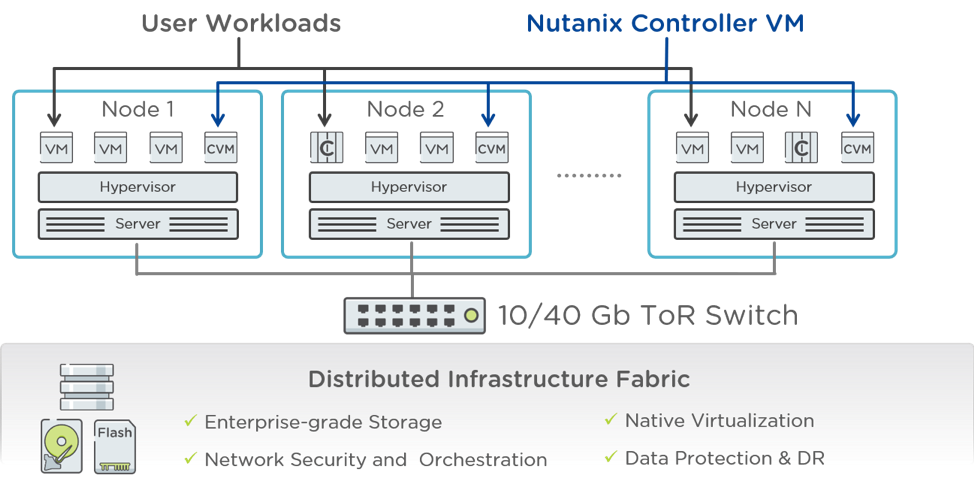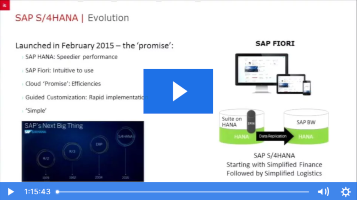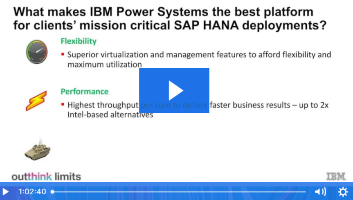Simplify Running SAP HANA
Hyperconvergence Brings Real-Time Infrastructure
SAP has a reputation as a forward-thinking company, seeking to help its customers reach new heights on a journey that is grounded in driving business value and embracing innovation. Most recently, a focus on enabling digital transformation has expanded to the vision of the intelligent enterprise that organizations can embrace to make them more competitive and better suited to achieve their missions. A key foundational component of this vision is SAP HANA, which offers organizations the opportunity to dramatically change the capabilities and velocity at which they do business. Manufacturing efficiency and time to market, retail strategy, customer retention, and financial organizations’ fraud and risk capabilities are just some of the areas where SAP HANA is driving digital innovation, bringing companies new value. To fully realize this vision, however, changes are required to the approach and delivery of the IT infrastructure used to power the business.
Luckily, the IT infrastructure ecosystem for running SAP applications and databases, including SAP HANA, is also in a paradigm shift. The public cloud has been one driver of the innovations witnessed in recent years. As IT, database, and application teams have learned how easy it can be to spin up a virtual machine on the cloud of their choice, they have started to demand this same experience for their SAP infrastructure. There is also the trend of on-premise solutions created from new technologies — like hyperconverged infrastructure (HCI) — that are not only scalable and flexible to adapt to change, but also fast to deploy and easy to manage. In the SAP HANA world, this means delivering customers a new solution option that can combine the advantages of the traditional approaches for running SAP HANA such as the standalone SAP HANA appliance delivery model and the SAP HANA tailored data center integration program.
“Non-production SAP HANA workloads typically account for about 30-50% of the total SAP HANA landscape, if not more, so these present a great opportunity for creating new efficiencies by taking advantage of the flexibility of a virtualized, common infrastructure resource pool and simplified deployment, updates, and retirement of instances.”
— Greg White, Solutions Marketing Principal, Nutanix
A New Hyperconverged Option for SAP HANA Customers
SAP recently announced a new certification for SAP HANA on HCI to provide more choices for its customers, helping them to reduce costs and complexity while realizing the value of SAP HANA. Since the start of this journey, Nutanix has partnered with SAP and shared its passion for innovation, for simplifying and driving efficiency, and for delivering business value and has helped demonstrate that, with minimal overhead, virtualized SAP HANA databases on HCI can achieve the performance and scalability required for successful deployments.
Performance is critical, but it has also become imperative for IT teams and Basis administrators to operate SAP landscapes more efficiently, minimizing management overhead and achieving faster time to value with easier deployment and scaling. This new certification will help organizations that are seeking infrastructure solutions that can satisfy growing needs while reducing the time spent on routine management tasks across an entire SAP landscape — from development and quality assurance (QA) to testing and production.
Nutanix Enterprise Cloud, which is now able to run SAP HANA workloads on the same software that is also certified for SAP NetWeaver and other SAP applications and use cases, builds on a foundation of hyperconvergence to create a flexible platform uniquely capable of solving challenges faced by SAP customers. The architecture converges servers, storage, data protection, virtualization, and networking with one-click operations, like performing a complete infrastructure software and firmware upgrade with zero-downtime, full application automation, and multi-cloud management, creating a software-defined solution that is ideally suited for deployment in primary data centers.
With a compact footprint and simplified remote management, Nutanix Enterprise Cloud is also perfect for secondary data centers, disaster recovery (DR) sites, and edge locations including production facilities, distribution centers, and remote or branch offices. All infrastructure and applications across an entire operation can be managed from a single interface — Nutanix Prism. Prism not only provides a consolidated view that is highly graphical and intuitive for both infrastructure and Basis teams to monitor and report on, it also leverages modern machine learning algorithms to predict future resource needs and provides proactive and actionable recommendations for better infrastructure administration. Nutanix software for running SAP landscapes, including application servers and databases, is layered on top of server platforms from Lenovo, Dell EMC, HP, Cisco, and more. Server nodes can be added incrementally and non-disruptively to a cluster when more storage or compute is needed, providing easy linear scaling and predictable performance. The hardware and software abstraction together provide SAP customers with a simplified journey to an enterprise cloud, which means they get to experience public cloud-like benefits — such as elasticity, simplified management, consolidated infrastructure visibility, and speed — in their private, on-premise infrastructure.
Simplify SAP HANA on Nutanix Enterprise Cloud
When it comes to running SAP HANA, Nutanix has partnered first with Lenovo and Dell EMC to offer solutions on their Intel Skylake SP-based platforms. SAP HANA and applications servers can run on the same cluster using a built-in, enterprise-grade hypervisor from Nutanix, AHV. Using AHV further simplifies infrastructure demands by removing another silo that must be maintained and updated, freeing teams to focus on new, value-add activities. Scale-up use cases with virtualized SAP HANA instances up to 2.3TB are initially supported in both production and non-production deployments.
Non-production SAP HANA workloads typically account for about 30-50% of the total SAP HANA landscape, if not more, so these present a great opportunity for creating new efficiencies by taking advantage of the flexibility of a virtualized, common infrastructure resource pool and simplified deployment, updates, and retirement of instances. Development, QA, sandbox, training, and other landscapes can be rolled out, expanded, and refreshed quickly and easily while also maximizing how the physical server and storage resources are consumed.
For production systems, a single management plane providing insight into all the elements of the infrastructure stack removes manual, time-consuming tasks and interactions with separate IT teams when Basis admins need to diagnose application issues and respond. By leveraging hyperconvergence and enterprise cloud for running SAP HANA, teams can experience the ease-of-use qualities of the appliance model along with the ability to adapt to changing needs of the SAP HANA tailored data center integration approach.

Investigate Hyperconvergence Today
Modern applications and databases, led by SAP and SAP HANA, have become key to the success of IT organizations in the digital age. The possibilities that HCI and enterprise cloud offer for SAP environments, now also including SAP HANA, are worth investigating to help meet the demands of digital and business innovation.
Nutanix Enterprise Cloud replaces the complexity of separate silos of infrastructure, increases resource utilization, and enables scaling for future demands while delivering the performance and availability that business-critical SAP landscapes need. As management tasks are reduced or eliminated, teams spend more time enhancing SAP applications and planning and delivering new services. To learn more about Nutanix Enterprise Cloud solutions for SAP software, visit Nutanix.com/sap.









